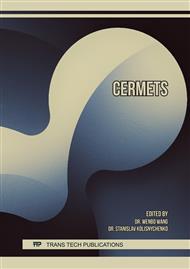[1]
C. Cheng, K. M. Reddy, A. Hirata, T. Fujita, M. W. Chen, Structure and mechanical properties of boron-rich boron carbides, J. Eur. Ceram. Soc. 37 (2017) 4514-4523.
DOI: 10.1016/j.jeurceramsoc.2017.06.017
Google Scholar
[2]
K.Y. Xie, V. Domnich, L. Farbaniec, B. Chen, K.J. Hemker, Microstructural characterization of boron-rich boron carbide. Acta Mater. 136 (2017) 202-214.
DOI: 10.1016/j.actamat.2017.06.063
Google Scholar
[3]
P. Ponnusamy, B. Feng, H.P. Martin, P. Groen, Effect of TiB2 nano-inclusions on the thermoelectric properties of boron rich boron carbide, Mater. Today 5 (2018) 10306-10315.
DOI: 10.1016/j.matpr.2017.12.278
Google Scholar
[4]
S.K. Vijay, R. Krishnaprabhu, V. Chandramouli, S. Anthonysamy, Synthesis of nanocrystalline boron carbide by sucrose precursor method-optimization of process conditions, Ceram. Int. 44 (2018) 4676-4684.
DOI: 10.1016/j.ceramint.2017.12.047
Google Scholar
[5]
T.S. Wang, Y. Zhang, P. Karandikar, C.Y. Ni, Structural evolution in reaction-bonded silicon carbide and boron carbide composites (RBSBC), Ceram. Int. 44 (2018) 2593-2598.
DOI: 10.1016/j.ceramint.2017.10.131
Google Scholar
[6]
L.N. Ma, K.Y. Xie, M.F. Toksoy, K. Kuwelkar, K.J. Hemker, The effect of Si on the microstructure and mechanical properties of spark plasma sintered boron carbide, Mater. Character. 134 (2017)274-278.
DOI: 10.1016/j.matchar.2017.11.010
Google Scholar
[7]
M. Nastasi, G. Peterson, Q. Su, Y.Q. Wang, P.A. Dowben, Electrical and structural characterization of neutron irradiated amorphous boron carbide/silicon p-n heterojunctions, Nuclear Instrum. Method Phys. Res. Sect. B 432 (2018) 48-54.
DOI: 10.1016/j.nimb.2018.07.006
Google Scholar
[8]
B.M. Moshtaghioun, D.G. García, A.D. Rodriguez, Exotic grain growth law in twinned boron carbide under electric fields, J. Eur. Ceram. Soc. 38 (2018) 4590-4596.
DOI: 10.1016/j.jeurceramsoc.2018.06.029
Google Scholar
[9]
N, Song, X.D. Li, Unveiling polytype transformation assisted growth mechanism in boron carbide nanowires, J, Cryst. Growth 481 (2018) 11-17.
DOI: 10.1016/j.jcrysgro.2017.10.013
Google Scholar
[10]
H. Guo, Z.W. Zhang, Processing and strengthening mechanisms of boron-carbide-reinforced aluminum matrix composites, Metal Powder Rep. 73 (2018) 62-67.
DOI: 10.1016/j.mprp.2017.06.072
Google Scholar
[11]
D.Q. He, L. Shang, Z.B. Lu, G. Zhang, Q.J. Xue, Tailoring the mechanical and tribological properties of B4C/a-C coatings by controlling the boron carbide content, Surf. Coat. Tech. 329 (2017) 11-18.
DOI: 10.1016/j.surfcoat.2017.09.017
Google Scholar
[12]
X. Li, S.B. Gao, P.F. Xing, K.Z. Dong, Z.B. Feng, Recovery and reutilization of high-quality boron carbide from sapphire wafer grinding-waste, J. Environ. Manag 224 (2018) 106-112.
DOI: 10.1016/j.jenvman.2018.06.088
Google Scholar
[13]
H.W. Zhang, D.G. Zhu, S. Grasso, C.F. Hu Tunable morphology of aluminum oxide whiskers grown by hydrothermal method, Ceram. Int. 44 (2018) 14967-14973.
DOI: 10.1016/j.ceramint.2018.05.072
Google Scholar
[14]
S. Bazazi, N. Arsalani, A. Khataee, A.G. Tabrizi, Comparison of ball milling-hydrothermal and hydrothermal methods for synthesis of ZnO nanostructures and evaluation of their photocatalytic performance, J.Indust. Eng. Chem. 62 (2018) 265-272.
DOI: 10.1016/j.jiec.2018.01.004
Google Scholar
[15]
J. Shi, J. Sun, B.J. Fang, Q.B. Du, J.N. Ding, Photoluminescence performance of Er/Yb co-doped NBT ceramics prepared via hydrothermal method, J. Phys. Chem. Solid 121 (2018) 228-235.
DOI: 10.1016/j.jpcs.2018.05.031
Google Scholar



